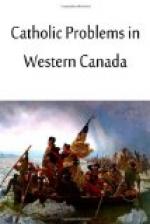“The Welfare Council begins its second year of life and activity. It has already, in a remarkable and effective way, shown the wonderful wealth of Catholic activity, and Catholic Service throughout the country; it has unified our Catholic organizations, leaving to all their autonomy; it has made Catholic faith a greater factor in American life; and under its leaders it will, without doubt, be a further source of strength, of help and co-operation to the entire Catholic body of the Country. It is the Catholic body expressing itself with one voice and one heart in the work and in the interests common to us all as Catholics.”—The N.C.W.C. Bulletin, Oct., 1920.
Fas est ab hoste doceri. . . . Powerful is the example of a brother, but often, stronger and more pungent is the example that comes from an enemy. There are times indeed, when shame and honour are stronger than love. This brings us to speak of the tremendous activities of our separated brethren. Never have their efforts in view of organizing their social service departments been so persistent and so manifest, particularly in the mission field. Doctrinal lines are being lowered and various denominations absorbed gradually into a “Church-union” scheme from coast to coast. A “social service programme” is the only binding element which is giving to them a fictitious unity. Fabulous sums are placed at the disposal of these bodies for home and foreign mission work. The Methodist Conference of Canada (1918—Hamilton) has pledged itself to levy $8,000,000 in the next four years for mission work. In our own country, in our Western Provinces, the field secretaries are most active among our Catholic foreigners. On the landing stage of our docks they are found to welcome the immigrants to our shores. And what could we not say of their “press activities!”
This movement for co-operation has, since the end of the war, taken tremendous proportions. Here is a fact which speaks volumes. . . . “The fight between Protestants and Catholics,” said a German Protestant minister, “will forthwith subside in the domain of dogma, but it will rise in the domain of social problems. No doubt truth in the social order will prevail as it has prevailed in the field of religious dogma. But we have to change our strategy, study new tactics, and in our




